Trieste Architecture
Explore Trieste Architecture: Churches, Palaces & More
Trieste architecture and the city of Trieste are dominated by the buildings surrounding the Unity of Italy Square. These neoclassical and eclectic-style palaces are reminiscent of the period when the city was part of the Austro-Hungarian Empire.
Additionally, there are several large churches representing a diverse range of religions. In addition to Trieste Cathedral, the Trieste Synagogue, Serbian Orthodox Church, and Evangelical Lutheran Church are all impressive architectural buildings. Lastly, there are several sites containing Roman ruins that should not be overlooked.
We spent a month in Trieste researching historic architecture. We’ve compiled a summary of the information we collected so you can start enjoying these sights as soon as you arrive!
If you’re interested in a walking tour of the best architecture, check out “29 Best Things to See in Trieste.”
This website contains affiliate links that may earn us a small commission at no additional cost to you.
Architecture in Unity of Italy Square
The large square surrounded by important government buildings and overlooking the sea represents the heart of Trieste. Once called Piazza Grande, it has changed its appearance several times over the centuries. Today no trace remains of the Austrian garden that once covered the area; however, the small sheltered harbor lives on in the blue lights embedded in the pavement.

Unity of Italy Square
aka Piazza Unità d’Italia
Address: Piazza dell’Unità d’Italia
The square has been the scene of significant historical events, a watershed between different eras, including the passage of the coffin of Franz Ferdinand, killed in Sarajevo in 1914, the landing of the Italian infantry troops in 1918, and the return of Trieste to Italy in 1954.

Trieste City Hall
aka Town Hall aka Palazzo del Municipio di Trieste aka Palazzo Cheba (meaning “cage”) aka Palazzo Sipario (meaning “curtain” because it hid the Old City).
- Architect: Giuseppe Bruni
- Style: Eclectic
- Built: 1873 to 1875
- Address: Piazza dell’Unità d’Italia, 4
The tower dominates the façade with the clock and two Moors, Mikeze and Jakeze, who ring out the hours.
It houses the offices of the Municipality of Trieste.

Palazzo del Lloyd Triestino
aka Palace of the Regional Government aka Palazzo of Lloyd Austriaco
- Architect: Heinrich von Ferstel
- Style: Renaissance
- Built: 1880 to 1883
- Address: Piazza dell’Unità d’Italia, 1
The building was completed in 1883 for the Lloyd Austriaco company, one of the oldest maritime businesses in the city. The two fountains on either side of the façade symbolize freshwater (Thetis) and saltwater (Venus), the two liquid kingdoms on which Lloyd’s fortune was based.
Since 1991 the building has been the seat of the Presidency of the Regional Council of Friuli Venezia Giulia.

Prefettura di Trieste
aka Prefecture aka Government Palace aka Palazzo della Luogotenenza Austriaca
- Architect: Emil Artmann
- Built: 1901 to 1905
- Address: Piazza dell’Unità d’Italia, 8
Formerly the Palazzo della Luogotenenza, this is the most recent building in the square. Its Byzantine-style golden mosaics glitter at sunset. The mosaics originally depicted the Austrian double-headed eagles, but were replaced in 1919 with the crosses of Savoy.
The building is now the seat of the Prefecture, the Commissariat of the Government of Trieste.
Designed by the Viennese architect Emil Artmann of the Historicism school, who taught for a long time at the Vienna Polytechnic, this work, too innovative at the time, was not widely appreciated in Trieste. Today, however, it has been reassessed and is often used as a film set.
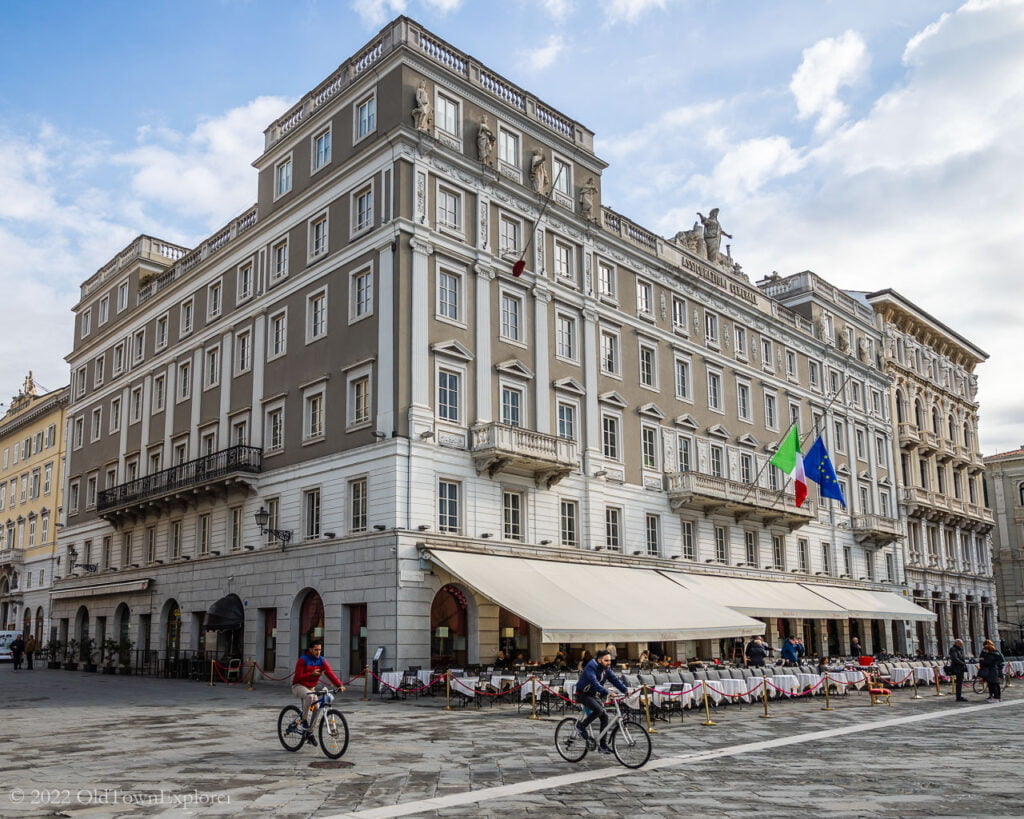
Palazzo Stratti
aka Casa Stratti
- Architect: Antonio Buttazzoni
- Style: Neoclassical (redesigned in Eclectic)
- Built: 1839 (redesigned in 1872)
- Address: Piazza dell’Unità d’Italia, 7
Once the home of the Greek merchant Niccolò Stratti, the building is now owned by Assicurazioni Generali. The historic Caffè degli Specchi is located on the ground floor.
At the top of the façade, a sculptural group celebrates the city of Trieste, progress, and commerce.
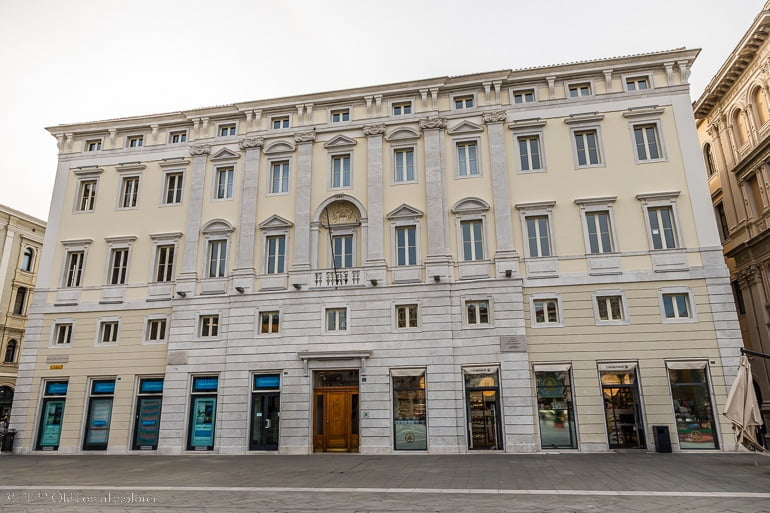
Palazzo Pitteri
aka Palazzo Plenario-Pitteri
- Architect: Ulderic Moro
- Style: Neoclassical with elements of late Viennese Baroque and Rococo
- Built: 1780
- Address: Piazza dell’Unità d’Italia, 3
This is the oldest building in the piazza. It was commissioned by the merchant Domenico Plenario. Today, the palace is known by the name of the family who lived there longest.
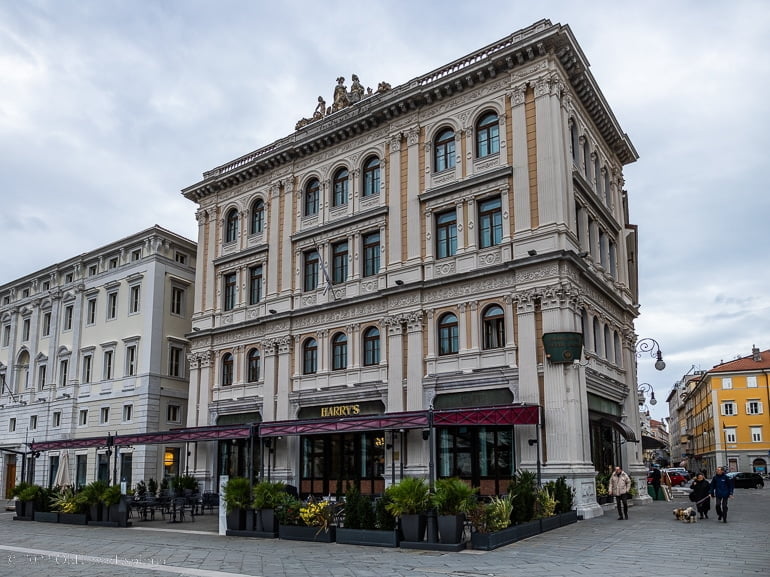
Palazzo Vanoli
aka Grand Hotel Duchi d’Aosta
- Architect: Eugenio Geiringer and Giovanni Righetti
- Style: Eclectic
- Built: 1972 to 1873
- Address: Piazza Unità d’Italia, 2, 34121 Trieste TS, Italy
Designed by Eugenio Geiringer and Giovanni Righetti in 1873, it has a rectangular plan and is spread over four floors in height. The main façade, which overlooks Piazza Unità d’Italia, has an eclectic style characterized by linear shapes. The ground floor is occupied by a café-restaurant, while the next three floors all feature a series of seven tripartite windows, separated by Corinthian pilasters. At the top of the first and third floors there is a frame decorated with floral motifs, and similar motifs are also present below the individual windows.
The façade is crowned by a balustrade with columns, in the center of which the date in Roman numerals MDCCCLXXIII stands out to remember the year of construction. Above the writing is a sculptural group formed by a female statue, a representation of Trieste, and the male figure of Mercury, the god of commerce. Behind Mercury is a putto, and the sculptural group is completed laterally by two cornucopia.
Palazzo Modello
- Architect: Giuseppe Bruni
- Style: Eclectic
- Built: 1872
- Address: Via del Teatro, 5, 34121 Trieste TS, Italy
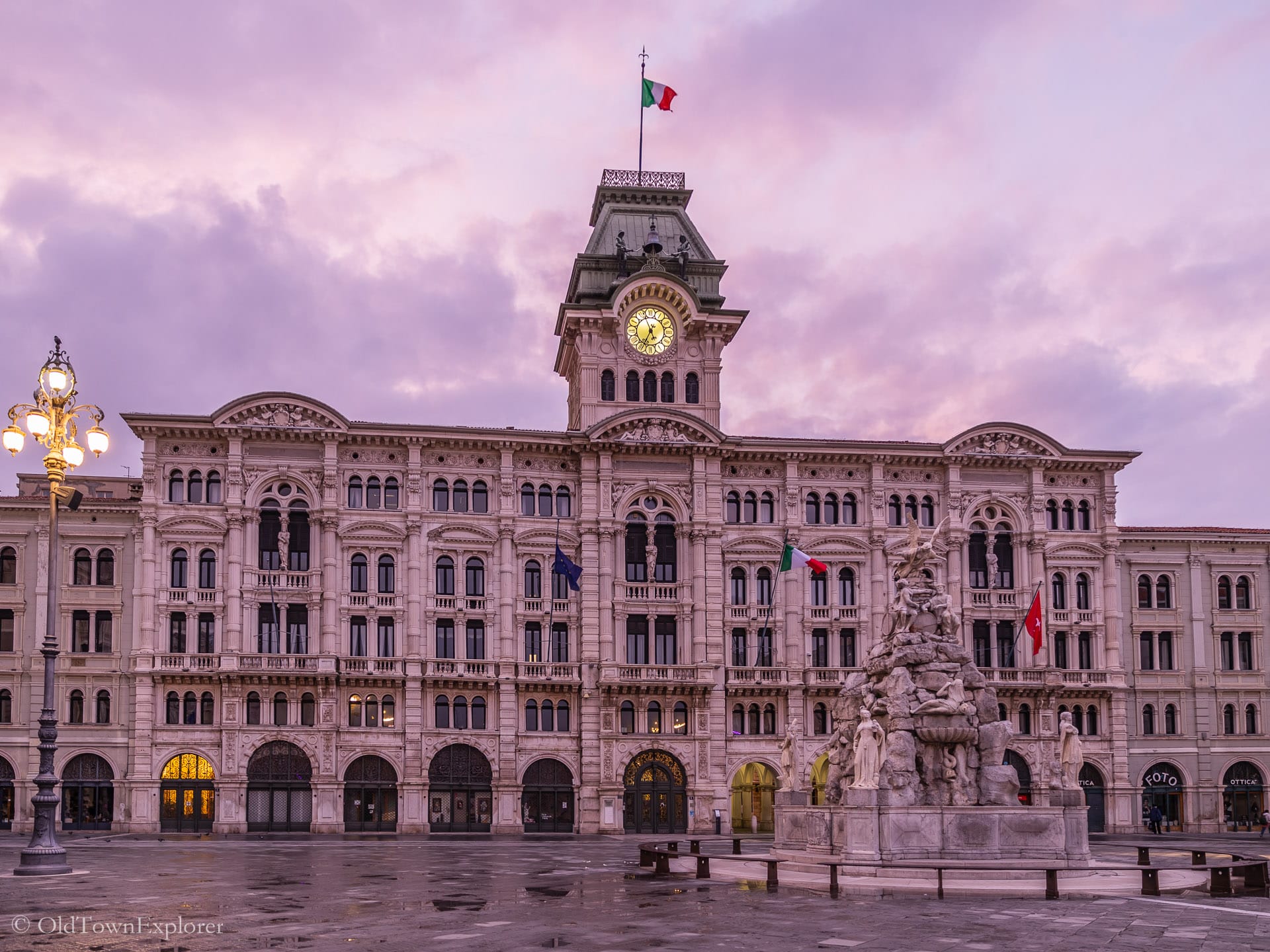
Fountain of the Four Continents
- Architect: Giovanni Battista Mazzoleni
- Built: 1751 to 1754
- Address: Piazza Unità d’Italia, 34121 Trieste TS, Italy
Architecture in Piazza della Borsa
Address: Piazza della Borsa
The Piazza della Borsa, originally the site of salt pans, became the economic center of Trieste in the 19th century. This attracted members of the upper middle class to build their palaces around the square.
The Piazza has the shape of an elongated triangle with one side stretching towards the Piazza dell’Unità d’Italia, one side tracing the former site of the Canale Piccolo, and the other side following the profile of the city’s ancient walls.

Palazzo del Tergesteo
aka Tergesteo Palace
- Architect: Francis Bruyn
- Style: Neoclassical
- Built: 1840 to 1842
- Address: Piazza della Borsa, 15
The Tergesteo Palace is an important building in Trieste. The ground floor is a shopping arcade, while the upper floors have been offices and residential apartments since its inauguration. It was originally home to the Trieste stock exchange.
A neoclassical palazzo from the mid-19th century, traversed by a cross-shaped glassed-in arcade. The original iron and glass ceiling of the gallery was demolished and replaced with a glass block structure during restoration ending in 1957. The original roof of the gallery was restored in 2011.
The sculptures on the main façades represent Commerce, Industry, and Navigation. In the center stands the figure representing Trieste as Tethys, the goddess of the sea.

Palazzo della Borsa Vecchia
aka Palazzo of the Old Stock Exchange aka the Old Stock Exchange Building
- Architect: Antonio Mollari
- Style: Neoclassical
- Built: 1802 to 1806
- Address: Piazza della Borsa, 14
Today, the building is Trieste’s Chamber of Commerce. Similar to the nearby Fountain of the Four Continents, the statues across the front are allegories of the four known continents. On the roof are other sculptures representing the Danube, Trieste, Minerva, and Neptune.
A giant sundial using a camera obscura traces a golden ellipse inside the building. The work of the famous watchmaker Antonio Sebastianutti was used to synchronize ships’ chronometers. In 2010, a second sundial, with fossils, was mounted on the exterior sandstone floor.

Bartoli House
- Architect: Max Fabiani
- Style: Art Nouveau
- Built: 1906 to 1098
- Address: Piazza della Borsa, 6
The Bartoli House is one of the city’s best-known and most famous Art Nouveau buildings. It was designed by Max Fabiani, a Mitteleuropa architect, and pupil of Otto Wagner at the Vienna Polytechnic. A cascade of leaves between the windows and elegant glass and cast-iron balconies dominate the façade.

Portizza
- Address: Piazza della Borsa, 5
The Portizza was originally one of the gates in the Medieval walls. It was defended by a tower and a bridge over the Canale Piccolo. Once the walls of the city disappeared, it was incorporated into 19th-century buildings.
The keystone shows a head of Hercules that recalls the so-called panduri, the grim faces of the ferocious Hungarian soldiers who fought the Turks and, once retired, became guardians of the palaces, first in flesh and blood and then in stone, as can be seen almost everywhere in the city.
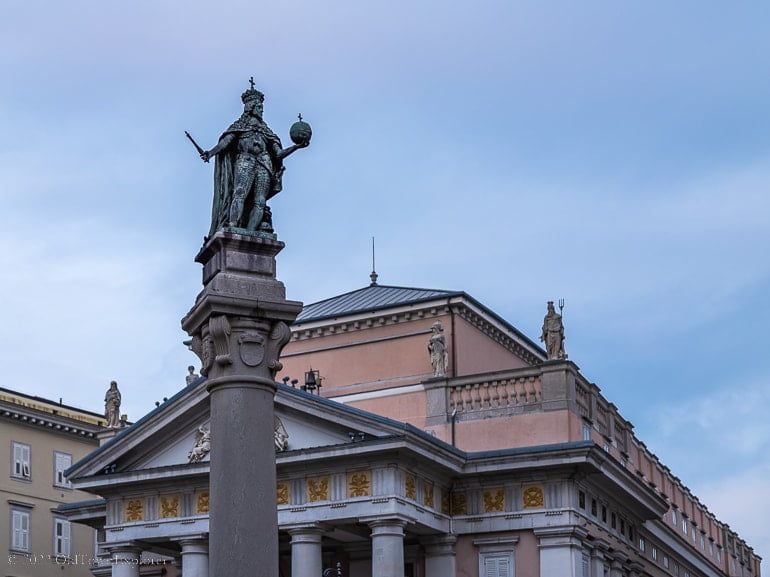
Statue of Leopold I
- Address: Piazza della Borsa
In 1660 Emperor Leopold I of Habsburg visited Trieste. To pay homage to him, a gilded wooden statue was erected in Piazza Pozzo del Mare. The statue was then re-cast in bronze in 1673 and moved to Piazza della Borsa in 1808, where it still stands today.
Palaces in Trieste
In addition to those in Unity of Italy Square and Piazza della Borsa, there are many other impressive palaces in Trieste.

Palazzo Carciotti
- Architect: Matthew Pertsch
- Style: Neoclassical
- Built: 1798 – 1805
- Address: Riva Tre Novembre, 13
Palazzo Carciotti, the home of the Greek merchant Demetrio Carciotti, is a jewel of neoclassical architecture designed by Matteo Pertsch. The palace includes the main house, sixteen apartments, and eighteen warehouses. The dome, topped by the Napoleonic eagle, served as an astronomical observatory. The sculptures of the deities are the work of Antonio Bosa, a pupil of Canova.

Palazzo Gopcevich
- Architect: Giovanni Berlam
- Style: Eclectic
- Built: 1850
- Address: Via Gioacchino Rossini, 4
Inaugurated in 1850, the residence of the Serbian shipowner Spiridione Gopcevich shows a façade with yellow and red motifs inspired by the Palazzo Ducale in Venice and architectural decorations that recall the history of the Serbian people. Today it houses the Carlo Schmidl Theatre Museum.
The building is one of the first and most important examples of Eclecticism in Trieste; indeed, Giovanni Berlam was one of the first Triestine architects to work with a variety of different historic architectural styles.

Main Post Office Building
aka Palazzo delle Poste Trieste
- Architect: Friedrich Selz
- Style: Eclectic
- Built: 1894
- Address: Piazza Vittorio Veneto, 1
The majestic Palazzo delle Poste, the main post office, is an eclectic 1894 work by the Viennese architect Friedrich Selz. It now occupies the area of ancient salt pans on which the previous Customs building had been erected. The Mitteleuropa Postal and Telegraph Museum is on the ground floor, the only one in Italy.
The palace is a quadrilateral that occupies the entire block, following the model of Austrian administrative buildings. The main façade is decorated with statues representing Navigation, Railway, Commerce, Viticulture, Agriculture, and Industry.

Palazzo Berlam
aka DoubleTree by Hilton Trieste
- Architect: Ruggero and Arduino Berlam
- Style: Neo-Renaissance
- Built: 1911 to 1914
- Address: Passo Costanzi, 2
Originally built for the RAS Insurance Company.
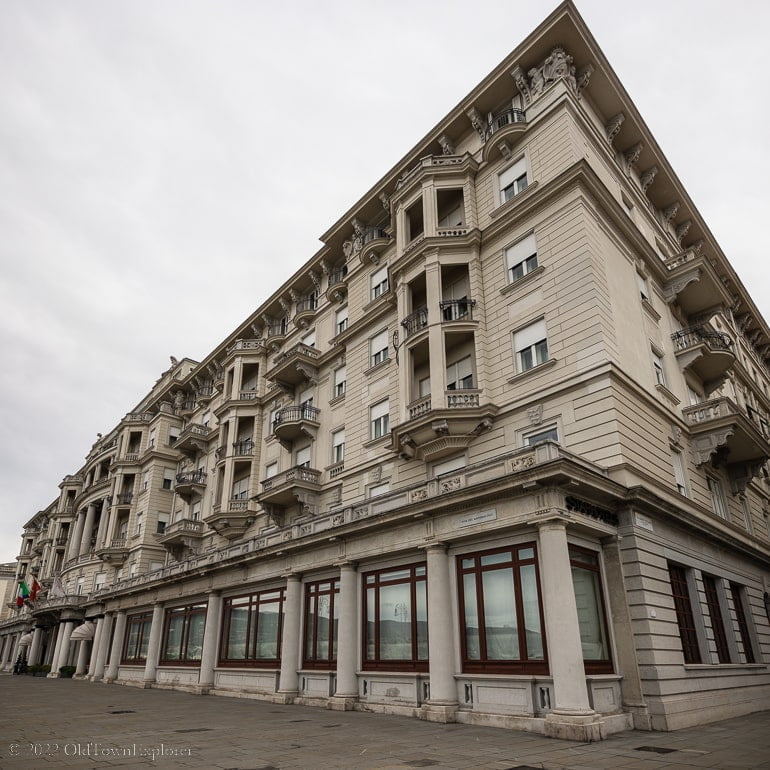
Savoia Excelsior Palace
- Architect: Ladislaus Fiedler
- Built: 1911 to 1912
- Address: Riva del Mandracchio, 4, 34124 Trieste TS, Italy
The Savoia Excelsior Palace is a luxury hotel in Trieste. It was billed as “the most important and luxurious hotel in the Austro-Hungarian Empire” when it opened.

Neogothic Palace
aka Palazzo Neogotico
- Style: Neogothic
- Built: 1912
- Address: Riva Grumula, 10
The neogothic-style palace was built at the far end of the seafront in the heart of the Borgo Giuseppino.

Terni-Smolars House
aka Casa Terni Smolars
- Architect: Romeo Depaoli
- Style: Art Nouveau
- Built: 1907
- Address: Via Dante Alighieri, 6
This Art Nouveau building has a large round window surrounded by female figures. The windows, balconies, railings, a pensile loggia, and a protruding cornice dominated by a dome are just some of the many elements that attract attention to this building and that change floor by floor.
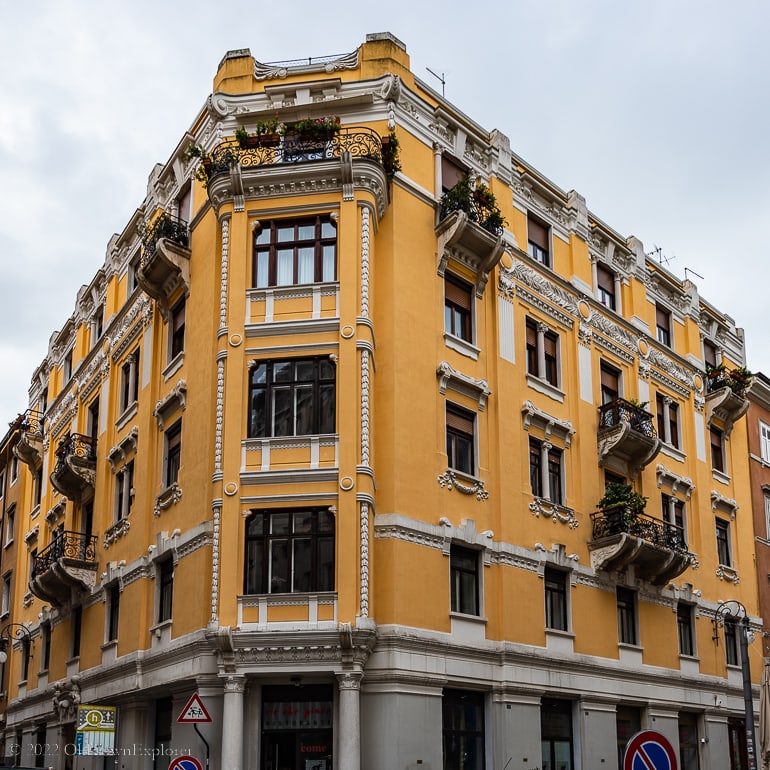
The Basevi House
aka Casa Basevi
- Architect: Eugenio Geiringer
- Style: Art Nouveau
- Built: 1892
- Address: Via San Giorgio, 5
This palazzo is a very early example of Art Nouveau, with elements borrowed from the classical tradition that are also present in buildings of an eclectic style. The façades have a complex decoration composed of plant friezes, floral garlands, medallions, and fluted pilasters.

Villa Necker
- Architect: Giacomo Marchini
- Style: Neoclassical
- Built: 18th century
- Address: Via dell’Università, 2
Among the villa’s many owners, it is worth mentioning the Egyptian merchant Antonio Cassis Faraone who bought it in 1790 and embellished its neoclassical forms. The next owner was Girolamo Bonaparte, Prince of Monfort and Napoleon’s younger brother. Today it is the headquarters of the Military Command of Friuli Venezia Giulia.
A plaque on the outer wall recalls that Giuseppe Carlo Bonaparte, Napoleon’s nephew, ironically nicknamed Plon Plon, was born here in 1822. The villa’s name derives from Teodoro Necker, the Swiss consul who bought it in 1823.

Hotel de la Ville
aka Fincantieri HQ
- Architect: Giovanni Degasperi
- Built: 1839 to 1841
- Address: Riva Tre Novembre, 11
Originally Hotel Metternich and later Hôtel de la Ville, it was one of the most famous hotels in the Austro-Hungarian Empire. Today, it’s now the headquarters of the Fincantieri shipbuilders.
Casa Agnani
- Architect: Eugenio Geiringer
- Style: Art Nouveau
- Built: 1901
- Address: Viale XX Settembre 32, 34125 Trieste TS, Italy
Eugenio Geiringer was a renowned architect in Trieste and designed many beautiful buildings in the city. One of his most famous works is Casa Agnani, built in 1901, which hosted the well-known Caffè Secession. The building is decorated with wreaths, medallions, and floral decorations and has become a famous landmark in Trieste.
Palazzo Brigido
- Architect: Giovanni Fusconi of Udine (circa 1732–1737)
- Style: Baroque with restrained ornamentation typical of early 18th-century noble residences in Trieste
- Built: Between 1732 and 1737, commissioned by Baron Giacomo Girolamo de Brigido
- Address: Via Pozzo del Mare 1, Trieste, Italy
Constructed in the early 18th century, Palazzo Brigido represents a noble Baroque townhouse positioned prominently on Via Pozzo del Mare near Piazza Unità d’Italia. Designed by Giovanni Fusconi, the building features a refined, orderly façade adorned with a heraldic family coat of arms, a subtle balcony, and classical details consistent with the period’s restrained aristocratic aesthetic. Notably, the palazzo hosted Napoleon Bonaparte in April 1797—an event commemorated by a plaque still visible on the façade. Today, this elegantly preserved historic building serves as a boutique lodging (B&B), aligning its architectural legacy with contemporary hospitality.
Palazzo Costanzi
- Architect: Pietro Nobile
- Style: Neoclassic
- Built: 1815
- Address: Passo Costanzi, 2
The Costanzi family was one of the most influential families in Trieste. The building now houses municipal offices, which are connected to the adjacent building by a covered passage, and the Sala Veruda, an exhibition venue.
Rotonda Pancera
- Architect: Matteo Pertsch
- Style: Neoclassical
- Built: 1805 to 1806
- Address: Via Felice Venezian, 27
The Rotonda Pancera was built for the merchant and magistrate councilor of Friulian origin, Domenico Pancera.
The building includes columns closed by the statues of Mars and Minerva and by friezes depicting heroic events of the Roman world with protagonists including Coriolanus, Virginia, and Iphigenia.
Churches in Trieste
While the churches may not dominate Trieste architecture to the extent they do other Italian cities, there are still several impressive churches in Trieste. Notably, there are significant buildings from a diverse group of religions including Catholicism (of course), Judaism, Lutheran, Serbian Orthodox, and Greek Orthodox.

Trieste Cathedral
aka Cattedrale di San Giusto Martire
- Style: Romanesque and Gothic
- Built: 1320 (opened)
- Address: Piazza della Cattedrale, 2
The first religious building on the site was built in the 6th century using part of an existing structure. Two basilicas were built on the ruins of the old church between the 9th and 11th centuries. In the 14th century, the two basilicas were joined by demolishing one nave of each basilica and constructing an asymmetrical façade with a Gothic rose window.
The two lateral apses are decorated with mosaics from the 12th and 13th-century Veneto-Byzantine schools. The central apse is from 1932. The central nave’s wrought-iron chandelier, donated by Maximilian of Habsburg, was initially intended for the Throne Room in Miramar Castle.

Church of Santa Maria Maggiore
aka Church of the Immaculate Conception of the Blessed Virgin Mary aka the Baroque Church of the Jesuits
- Style: Baroque
- Built: 1627 (consecrated in 1682)
- Address: Via del Collegio, 6
The church of Santa Maria Maggiore church was built by the Jesuits in the 17th century but has been managed by the Franciscans since 1922. The church is at the foot of the San Giusto hill near the Basilica of Christ the Savior (formerly the Basilica of San Silvestro).

San Silvestro Basilica
Basilica di San Silvestro aka Basilica of Christ the Savior
- Style: Romanesque
- Built: unknown; consecrated 1332
- Address: Piazzetta S. Silvestro, 1
This is the oldest place of worship in Trieste. In 1784, after the closure of many Catholic churches imposed by the Austrian Emperor Joseph II, it was sold to the Helvetic community, which now manages it with the Waldensians.
Popular belief has it that the church stands on the foundations of the birthplace of the early martyrs Euphemia and Thecla.
The bell tower may have been built for defensive purposes in medieval times. The layout has no apse.

Trieste Synagogue
aka Israelitic Synagogue and Temple
- Architect: Arduino Berlam, Ruggero Berlam
- Style: late Roman
- Built: 1908 to 1912
- Address: Via San Francesco, 19
The synagogue, one of the largest in Europe, replaced the four small preexisting ones. Today it is recognized as one of the most important places of worship for Jews in Europe.
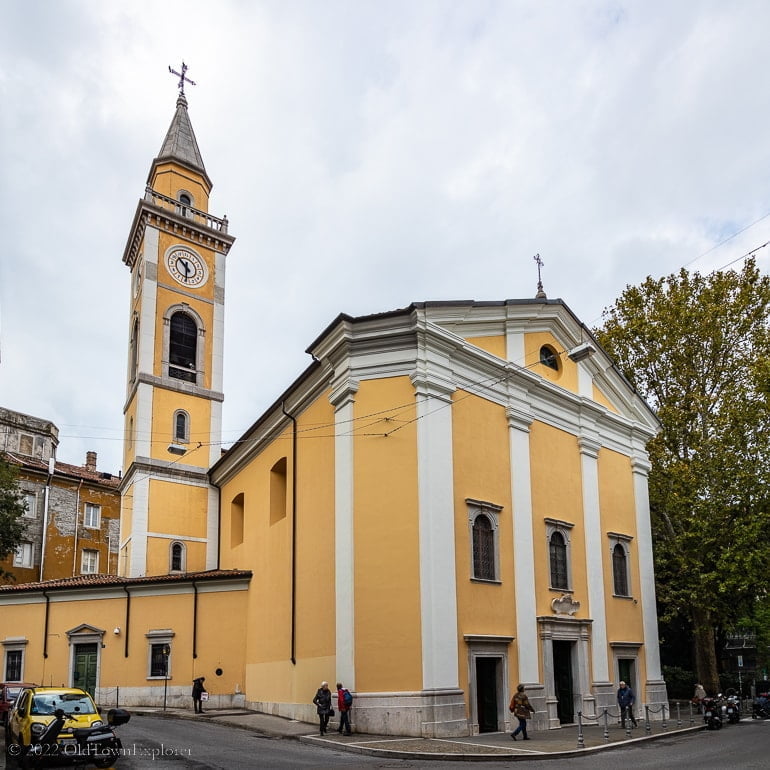
Church of the Beata Vergine delle Soccorso
aka Chiesa Sant Antonio Vecchio
- Architect: Giuseppe Bernardi
- Built: 1847; enlarged 1864
- Address: Piazzetta Santa Lucia, 2, 34123 Trieste TS, Italy
The church became a subsidiary of Santa Maria Maggiore, obtaining the baptismal font in 1813. In 1864, based on a project by Giuseppe Bernardi, it was enlarged, assuming its current form, and was blessed on 16 July 1866 by Bishop Bartolomeo Legat. Other conservation works were carried out in later times and recently involved the presbytery, the painting of the hall, and the restoration of the stuccos and paintings on the ceiling.

Serbian Orthodox Church of San Spiridione
- Architect: Carlo Maciachini
- Built: 1869
- Address: Via San Spiridione, 9
The floor plan is a Greek cross surmounted by a large dome and four small Byzantine domes. Among the colorful mosaics, frescoes, and icons covered with precious stones, a silver lamp donated by Pavel Romanov, Tsar Paul I of Russia, stands out. The façade is partly covered with stone from the quarries of Santa Croce and Brioni.

Evangelical Lutheran Church
aka Lutheran Evangelical Church (Luternasko Evangeličanska Cerkev)
- Architect: Zimmermann of Wroclaw
- Style: Neogothic
- Built: consecrated in 1874
- Address: Largo Odorico Panfili, 1, 34132 Trieste TS, Italy
One of the many effects of the Free Port regime in Trieste was a strong presence of German merchants and administrators in the city, so much so that the Augsburg (or Augustan) Confession Evangelical Community was already legally constituted by 1778. The church, consecrated in 1874, was designed in Neogothic style by the architect Zimmermann of Wroclaw.

Greek Orthodox Church of Saint Nicholas
aka Greek Orthodox Church of San Nicolò
- Architect: Matteo Pertsch (redesign)
- Style: Neoclassical
- Built: 1784 to 1787; redesigned 1820
- Address: Riva Tre Novembre, 7
Inside are two large canvases by Cesare Dell’Acqua, Maximilian of Habsburg’s favorite painter, and an engraved silver iconostasis illuminated by the lights and colors of sunset.

Church of Sant’Antonio Nuovo
aka Church of Saint Antonio Taumaturgo
- Architect: Pietro Nobile
- Style: Neoclassical
- Built: 1825; consecrated 1849
- Address: Piazza Sant’Antonio Nuovo
The largest church in Trieste is located in the square, also known as Sant’Antonio Nuovo, at the end of the Grand Canal.
The six Ionic columns support the tympanum, which is decorated with the statues of the martyrs of Trieste: San Servolo, Santa Eufemia, San Giusto, San Sergio, Santa Tecla, and Sant’Apollinare.
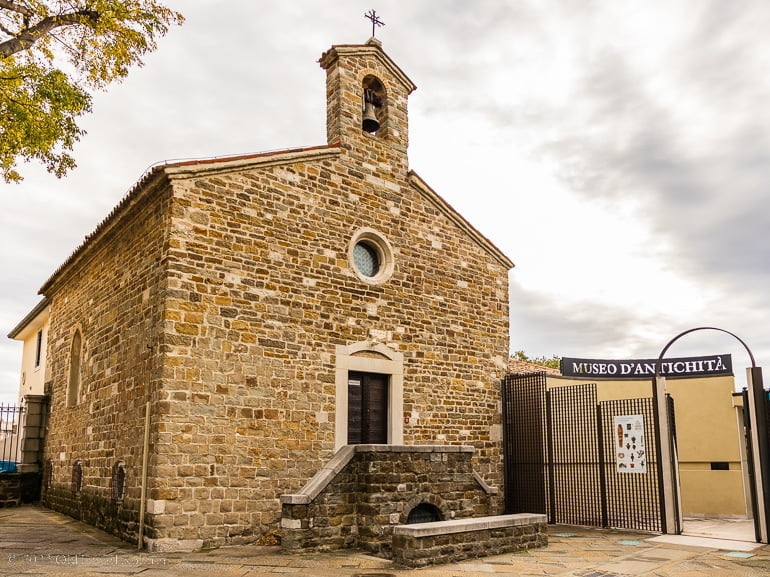
Chiesetta Di San Michele Al Carnale
aka Saint Michele of Carnal aka Chiesa Rettoria Oratorio San Michele al Carnale
- Style: Romanesque
- Built: 13th or 14th century
- Address: Piazza della Cattedrale, 4, 34124 Trieste TS, Italy
A quietly authentic medieval structure, the Chiesetta di San Michele al Carnale stands next to Trieste Cathedral and was historically connected to the nearby city cemetery, serving as its chapel. Its exterior remains largely original, marked by its simple rose window and modest bell-gable. Inside, the space feels more modern, with recent paintings that contrast with the church’s austere shell. Visitors note that the chapel is often closed, and its interior is relatively minimal compared to neighboring historic churches. It’s a contemplative stop easily paired with a visit to the adjoining Lapidary Garden.
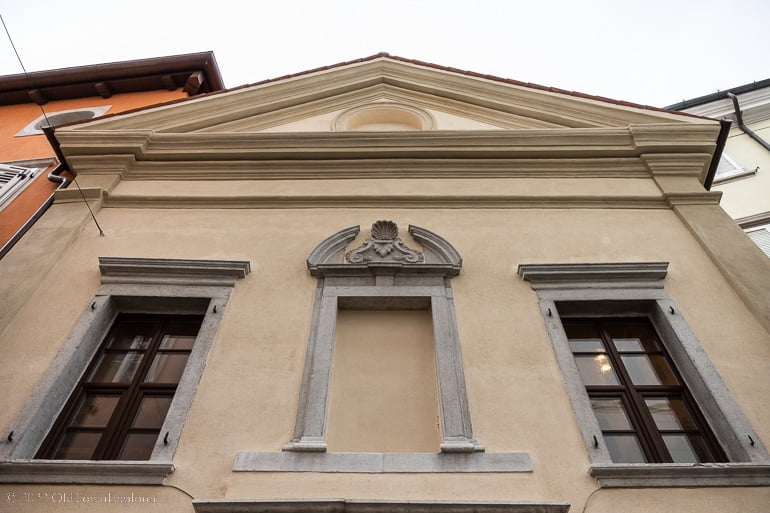
Church of Saints Sebastiano and Rocco
- Built: 1543
- Address: Via San Sebastiano, 3
The initial church dedicated to San Sebastiano was built in 1365 on land seized from the Ranfo family after a foiled conspiracy. In 1543 it was replaced by the current one, also dedicated to San Rocco, the protector against the Plague.
The church was deconsecrated and sold after the proclamation of Giuseppe II in 1782. Today it still preserves the tympanum and the shell above the main window, a typical attribute of the San Rocco the pilgrim. Unused for a long time, after the recent restoration, it has been used for commercial purposes.
Museums in Trieste
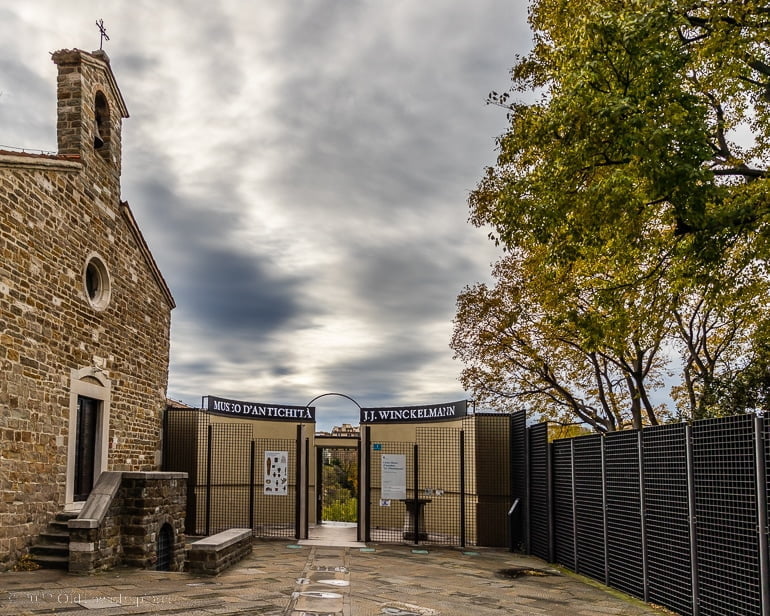
J. J. Winckelmann Antiquity Museum and Lapidary Garden
Museo d’Antichità J.J. Winckelmann
- Address: Piazza della Cattedrale, 1
The museum bears testimony to the passion for collecting that was typical of merchant families of Trieste who, as sea traders, went hunting for exotic objects. Do not miss the local history section and the Winckelmann cenotaph, recalling the father of modern archaeology who was murdered in Trieste in 1768.
The gardens contain tombstones and valuable Roman and modern pieces saved from destruction over the last few centuries.

Revoltella Museum Gallery of Modern Art
- Address: Via Armando Diaz, 27
The Revoltella Museum Gallery of Modern Art was created by the will of Baron Pasquale Revoltella, who donated his palace with its furnishings, library, and art collections to the city. The Baron, who became wealthy through investments in the Suez Canal, collected the works of the foremost Triestine artists – Veruda, Wostry, and Rietti. The collection was later increased with appropriate purchases, and the building was developed further through Carlo Scarpa’s expansion project.
Antiquarium di via del Seminario Museum
- Address: Via del Seminario
A stretch of the walls built by Octavian in 33-32 BCE to defend the Roman colony of Tergeste that was perched atop the top of the Hill of San Giusto is visible. You can also see the channel at its base that conveyed rainwater downstream off the hill.
From the beginning of the 2nd century, the walls were no longer used for defensive purposes but as a containment and terracing structure for the buildings uphill. On the site, there is also a tank lined with terracotta, probably used to produce olive oil.
Civic Museum of the Risorgimento and Shrine to Guglielmo Oberdan
- Architect: Umberto Nordio
- Built: 1934
- Address: Via XXIV Maggio, 4
The Casa del Combattente, housing the Civic Museum of the Risorgimento, the Sacrario (Shrine), and the cell of Guglielmo Oberdan, stand on the area once occupied by the main Austrian barracks. The frescoes by Carlo Sbisà depict Julian and Dalmatian volunteers during the Great War.
Statues and Monuments in Trieste

Trieste War Memorial
Monumento ai Caduti
- Architect: Attilio Selva (the sculptural group) and Enrico Del Debbio (the base)
- Built: 1935
- Address: Parco della Rimembranza, 34100 Trieste TS, Italy
The Monumento ai Caduti is a monument dedicated to the fallen of the First World War in Trieste located inside the park of remembrance on the Colle di San Giusto in Trieste.
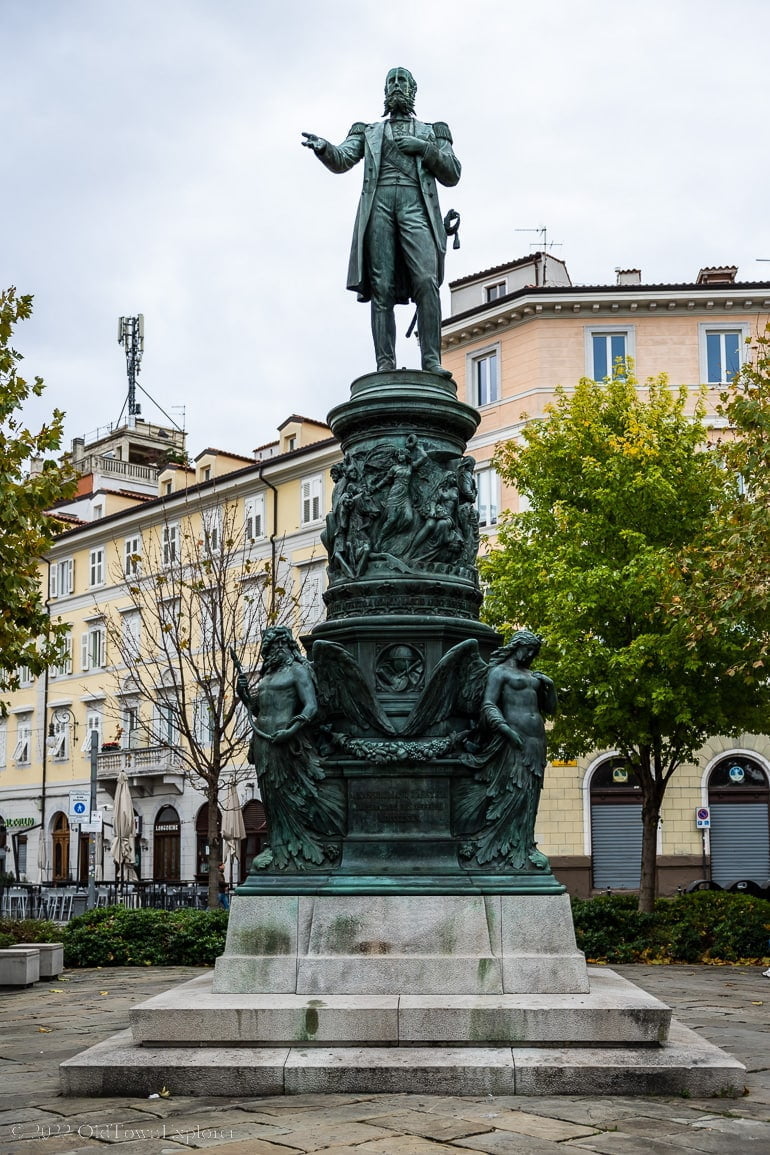
Monument to Archduke Maximilian of Austria
aka Statua Massimiliano d’Austria Imperatore del Messico
- Sculptor: Johann Schilling
- Created: 1875
- Location: Piazza Venezia
The monument depicts Maximilian in the uniform of an Austrian admiral, pointing towards Miramare. Like the fountain in Piazza Unità, the pedestal represents the four continents.
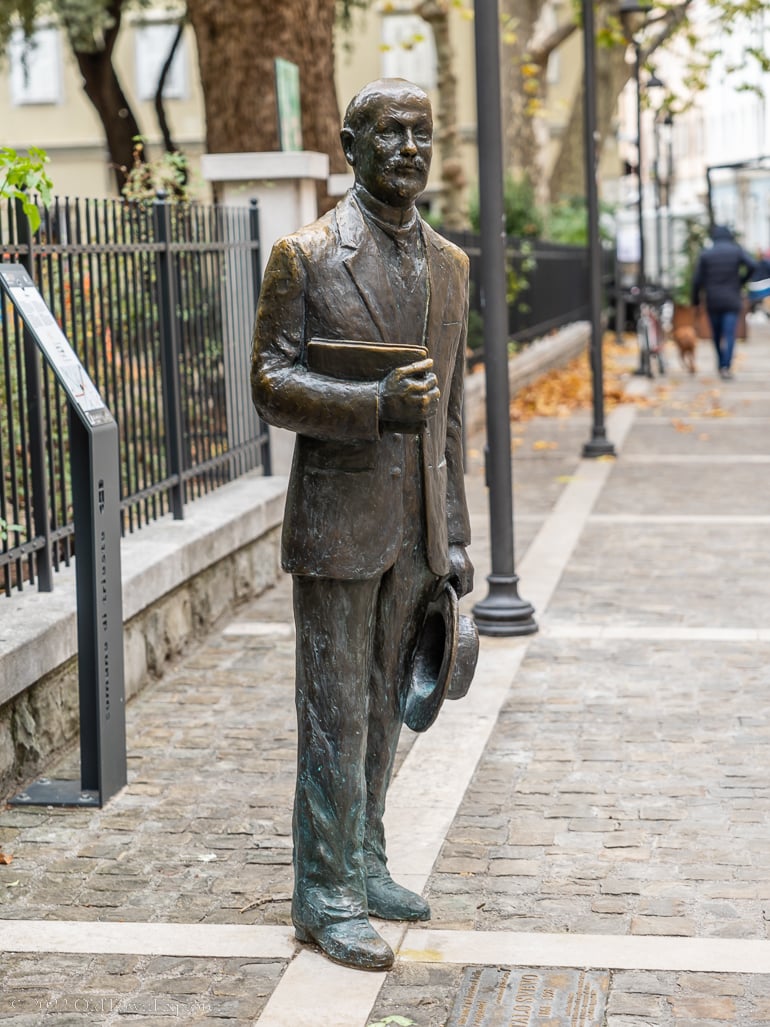
Statue of Italo Svevo
- Sculptor: Nino Spagnoli
- Created: 2004
- Location: Piazza Attilio Hortis
The sculpture, created by Triestine Nino Spagnoli in 2004, features Italo Svevo, the pseudonym of Aron Hector Schmitz, also known as Ettore (1861-1928), hat and book in hand, making his way to the Civic Library, as he did during his life, like Saba, Slataper, Burton, Joyce and other writers.

Statue of James Joyce
- Sculptor: Nino Spagnoli
- Created: 2004
- Location: Via Roma
The Irish writer James Joyce (1882-1941) arrived in Trieste in 1904 with his partner Nora. The couple moved often and, for a short time, lived on Piazza Ponterosso on the third floor of the building that now houses the cafè of the same name. The statue by Nino Spagnoli was placed here in 2004.
The fruit and vegetable market once held on this spot is perhaps remembered in a passage from the prose poem Giacomo Joyce, set in Trieste: “The sellers offer on their altars the first fruits: greenflecked lemons, jewelled cherries, shameful peaches with torn leaves.”
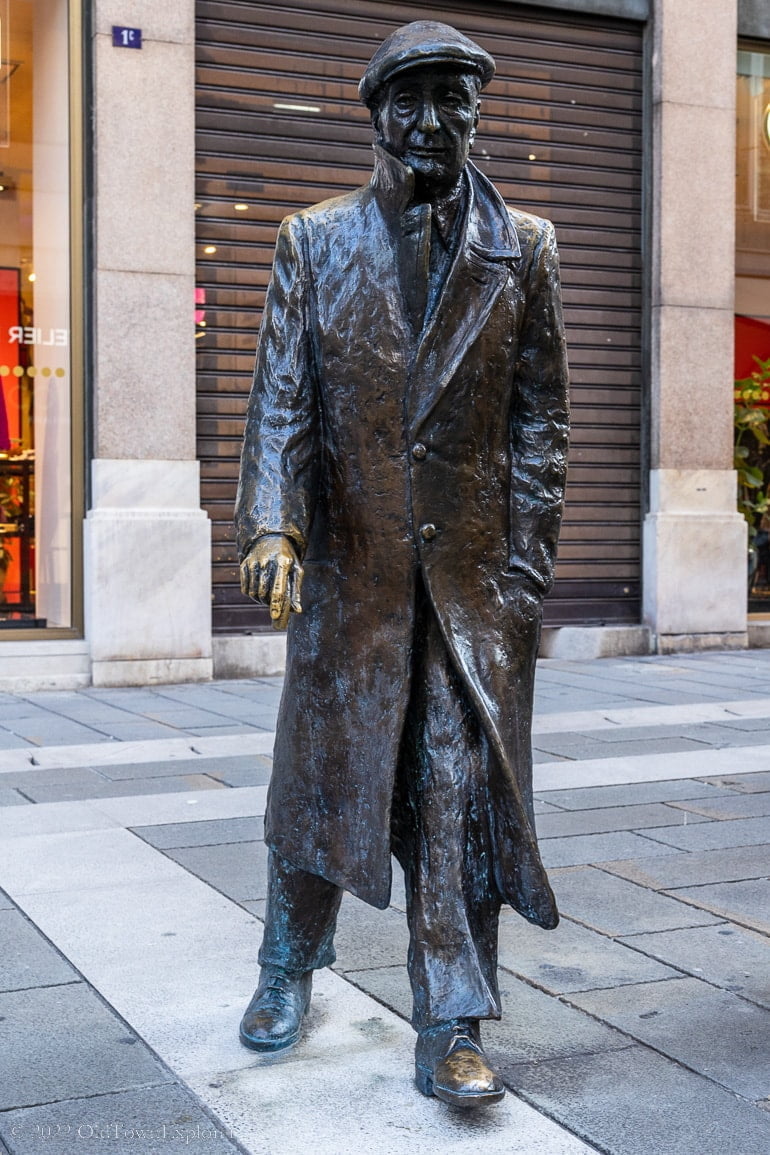
Statue of Umberto Saba
- Sculptor: Nino Spagnoli
- Created: 2004
- Location: Via Dante Alighieri, 2
The poet Umberto Saba, the pseudonym of Umberto Poli (1883-1957) was born in Trieste to a Jewish family. From the end of the First World War until his final days he devoted himself to his antiquarian bookshop and to the writing of his beloved Canzoniere. The sculpture by Nino Spagnoli dates from 2004.
Saba dedicates the final triplet of the poem Trieste to his antiquarian bookshop, the cantuccio just a few steps from here in via San Nicolò: “My city that is alive in each of its parts, | has a corner made just for me and my life, | pensive and reserved.”

Statue of Josef Ressel
- Created: 2022
- Location: Riva Tre Novembre, 11, 34121 Trieste TS, Italy
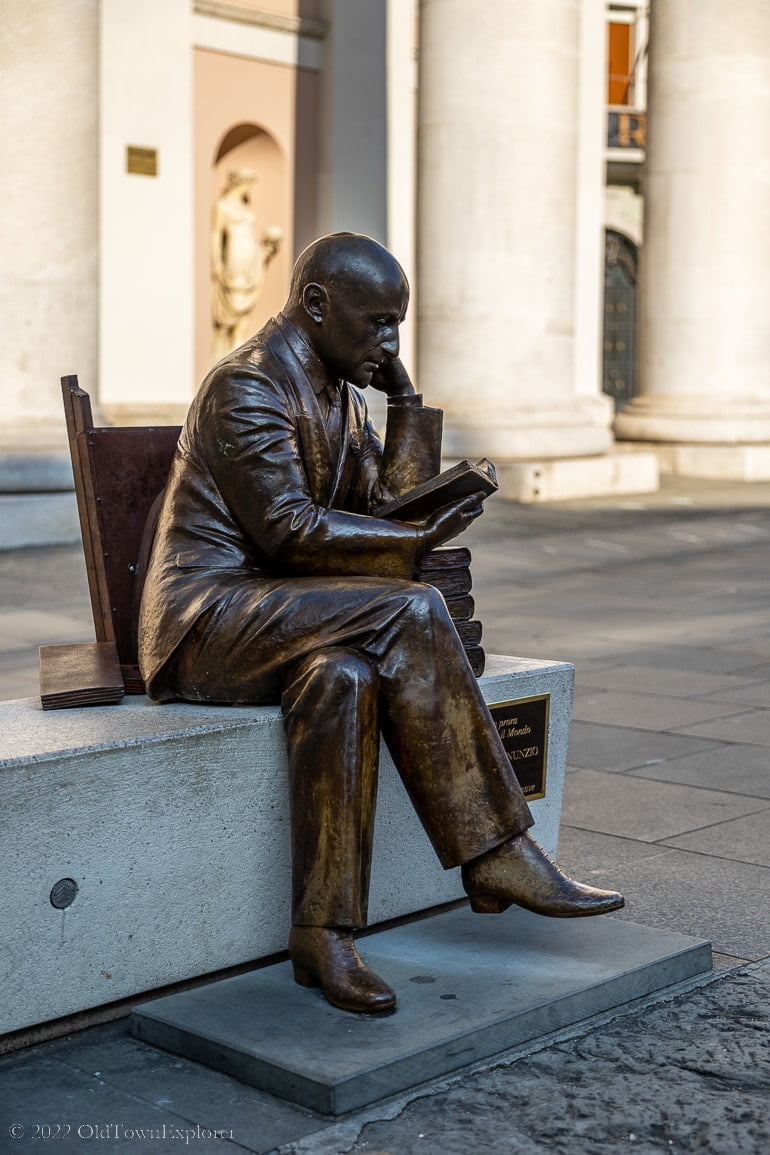
Statua di Gabriele D’Annunzio
- Sculptor: Alessandro Verdi
- Created: 2019
- Location: Piazza della Borsa, 34121 Trieste TS, Italy
Other Attractions in Trieste
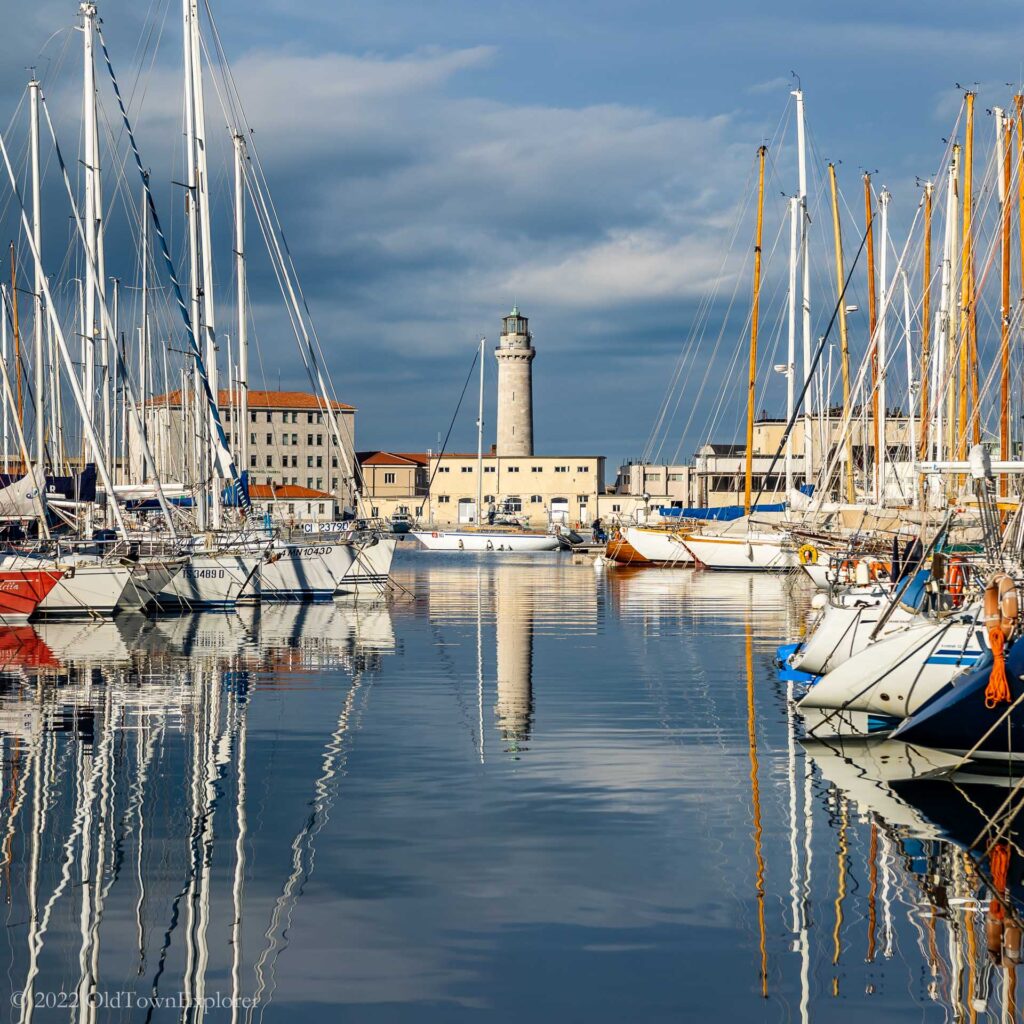
Ex Lighthouse La Lanterna
- Architect: Matteo Pertsch
- Built: 1830 to 1833
- Address: Molo Fratelli Bandiera, 9
The old lighthouse of Trieste is situated on the Molo Fratelli Bandiera, 9 where maritime signals existed in Roman times.
The unpainted white stone lighthouse was ordered by Carlo Zinzendorf and designed by the architect Matteo Pertsch. It was constructed in 1830 and went into active use in 1833. The lighthouse is a 31 m (102 ft) round stone tower with a lantern and gallery, rising from a circular 2-story stone building that was also intended for military defense.
It has been inactive since 1969.

Salone degli Incanti
aka Santa Maria del Guato (a reference to the size of the vaults and the tower that resembles a bell tower, see it as a basilica dedicated to the guato, the goby, a very common fish in the gulf)
- Architect: Giorgio Polli
- Style: Art Nouveau
- Built: 1913
- Address: Riva Nazario Sauro, 1
Fish auctions (incanti) were once held in the old fish market, which is now home to events and temporary exhibitions. It has a tower that once distributed seawater to the fish counters and today supplies the tanks for the adjoining Civic Marine Aquarium of Trieste.

Antico Magazzina Vini
aka The Ancient Wine Warehouse aka Eataly Trieste
- Built: 1902
- Address: Riva Tommaso Gulli, 1
Inaugurated in 1902, the building once stored the barrels from Istria and Dalmatia, kept at a constant temperature by what was then an innovative watering system. Completely renovated and equipped with a spectacular view of the Gulf, since 2017 it has been the home to Eataly Trieste.

Audace Pier
aka Molo Audace
- Built: 1740 (original); 1860 to 1861 (enlarged)
- Address: Molo Audace
The 246 meters long pier is made from local sandstone. At the end is a characteristic bollard with a wind rose.
The pier is named for the Audace, the first ship of the Italian Royal Navy to enter the port of Trieste and dock at the pier at the end of World War I in 1918.
The Audace Pier is beloved by locals as the ideal place for evening walks to enjoy the sunsets with Miramare Castle and the Alps in the distance.

Roman Theatre of Trieste
- Built: 1st century
- Address: Via del Teatro Romano
The theatre was built outside the walls, in an area by the sea at the time. It could accommodate more than 6,000 spectators. In the Middle Ages, it was buried by the houses that were built over it. After nearly 2,000 years, it was excavated and restored in 1938. Today, it is still the site of shows and artistic events.

San Giusto Castle
Castle of Saint Giusto aka Castello di San Giusto
- Built: 1468 to 1630
- Address: Via della Cattedrale, 3
The initial core of the Castle, the so-called Casa del Capitano, was incorporated into the triangular fortress, and differently shaped bastions of the Rotondo, Lalio, and Fiorito were added over the centuries. It was opened to the public in 1936 after extensive restoration.
Today, the Castle is one of the hubs of the city’s cultural life, hosting various museums. During the summer, it becomes the venue for outdoor shows and concerts.

Tor Cucherna
- Built: 14th century
- Address: Via della Chiauchiara, 7
The Tor Cucherna is a Medieval tower originally used for surveillance of the city walls.
The Tor Cucherna was spared when the walls of Trieste were destroyed because it had been transformed into a home.
In 1910, the tower was restored and the brickwork in the upper part was added to it.

Richard’s Arch
Arco di Riccardo
- Built: 1st century
- Address: Piazzetta Riccardo
This is one of the Roman city’s gates that was built as a way to the monumental area of the hill of San Giusto.
At the beginning of the 20th century, it was the main thoroughfare of a densely-populated area of taverns and meeting places. The arch was partly uncovered by excavations conducted in 1913 and separated from the houses on one side.
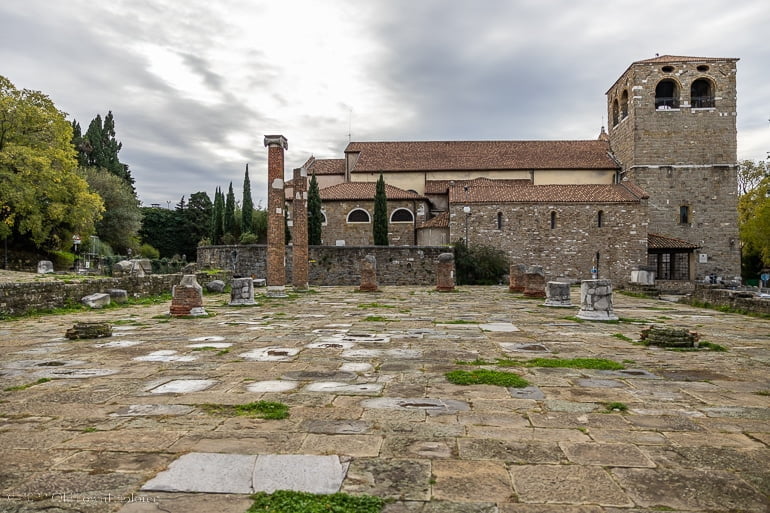
Roman Forum
- Built: 1st century
- Address: Piazza della Cattedrale
At the top of the Hill of San Giusto are exposed ruins of the ancient Roman city. The bell tower’s base incorporates the propylaea, the entrances which lead to the area. Opposite you can see the Forum and the remains of the civil Basilica, a three-nave building used for justice and business.
The remains of the Forum were discovered in 1929 during excavations for laying the bronze World War I monument. The columns were partly reconstructed in red brick to highlight the original forms, as was the archeological practice at the time.
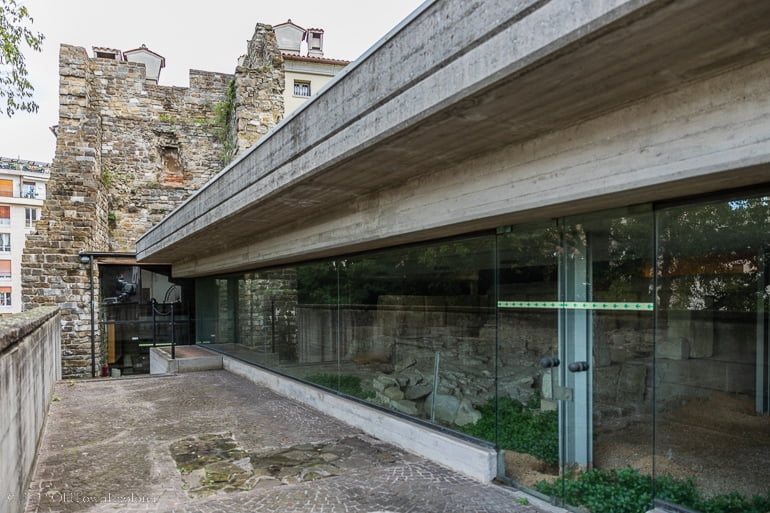
Antiquarium di Via Donota
- Address: Via di Donota
The use of this site has varied over the centuries, ranging from a dwelling to a manufacturing site, a burial ground, and, finally, the base of a tower in Medieval times. The Antiquarium also exhibits objects from the excavations of the Cittavecchia area.
Medieval Houses
- Built: 14th century
- Address: Via San Silvestro, 5
In recent years the foundations of some late medieval residential buildings have been found, dating back to the 14th century.
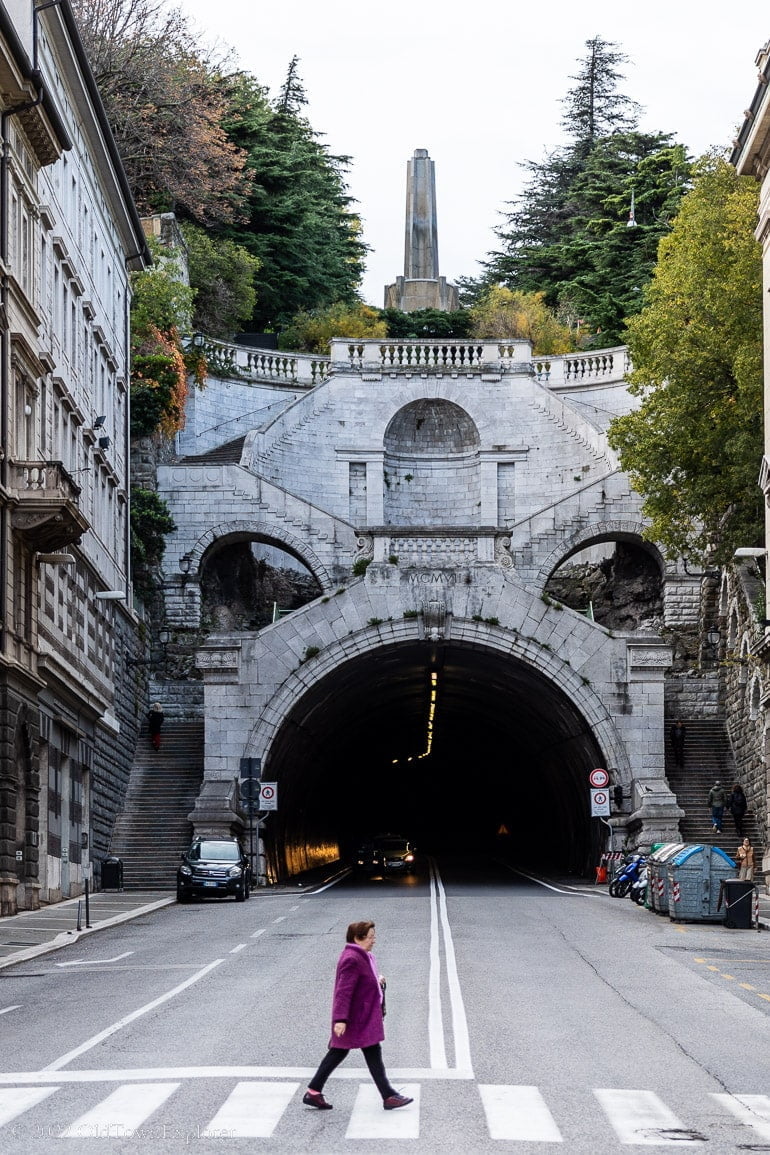
Giants’ Stairway
Scala dei Giganti
- Architect: Ruggero Berlam and Arduino Berlam
- Built: 1904 to 1905
- Address: Galleria Scipione De Sandrinelli, 7, 34131 Trieste TS, Italy
The Giants’ Stairway begins at the base of Piazza Carlo Goldoni, passes through Via del Monte, and finally reaches San Giusto.
Things to Know About Trieste Architecture
Digital and Interactive Architectural Projects in Trieste
Digital and Interactive Architectural Projects leverage technology to enhance the visitor experience in Trieste. By integrating digital tools like audio guides and interactive displays, tourists can delve deeper into the architectural history of the city. These innovative projects bridge the gap between traditional sightseeing and modern exploration, allowing individuals to interact with Trieste’s rich architectural heritage in a dynamic and engaging manner.
City Tours in Trieste
Guided Tours
Want to learn about Trieste’s history with a guide? Book a highly-rated city tour!
Best Places to Stay in Trieste
Hotels in Trieste
There are many great places to stay in Trieste. For the best experience, we recommend staying near the Piazza Unita d’ Italia (the castle marker on the map below). Northeast of the castle marker is a great area with historic churches, cafes, the canal, and many restaurants. Southwest of the castle marker is a beautiful area with older churches and buildings, small shops, restaurants, and cafes.
Here’s an interactive map with hotel and apartment options that can be filtered to meet your needs. Select your travel dates to get specific availability and prices.
Book your stay now!
FAQs About Trieste Architecture
What Is the Architecture Style of Trieste?
Trieste has a diverse architectural style due to its history of being ruled by different empires and nations. It features Gothic, Renaissance, Baroque, Neoclassical, Art Nouveau, and Modernist architecture styles.
Why is Trieste unique?
Trieste is known for its diverse architecture, including Roman ruins, neoclassical buildings, and art nouveau structures. Additionally, Trieste is situated on the Adriatic Sea and has a bustling port that serves as a gateway to central Europe.
What Is Trieste, Italy Known For?
Trieste is located in northeastern Italy, near the border with Slovenia. It is known for its cultural heritage and picturesque scenery, as well as its important role in European history. Some of the things that Trieste is known for include:
1. Historic Architecture: Trieste has a unique blend of architectural styles, including Roman, Gothic, Baroque, and Art Nouveau.
2. Coffee Culture: Trieste is famous for its coffeehouses and cafes dating back to the 18th century.
3. Literary History: Many famous writers and poets have lived in Trieste, including James Joyce and Umberto Saba.
4. Scenic Location: Trieste is situated on the Adriatic Sea and is surrounded by beautiful hills and countryside.
5. Cosmopolitan Vibe: Due to its strategic location at the crossroads of different cultures and civilizations, Trieste has a diverse and cosmopolitan population that reflects its vibrant history and culture.
